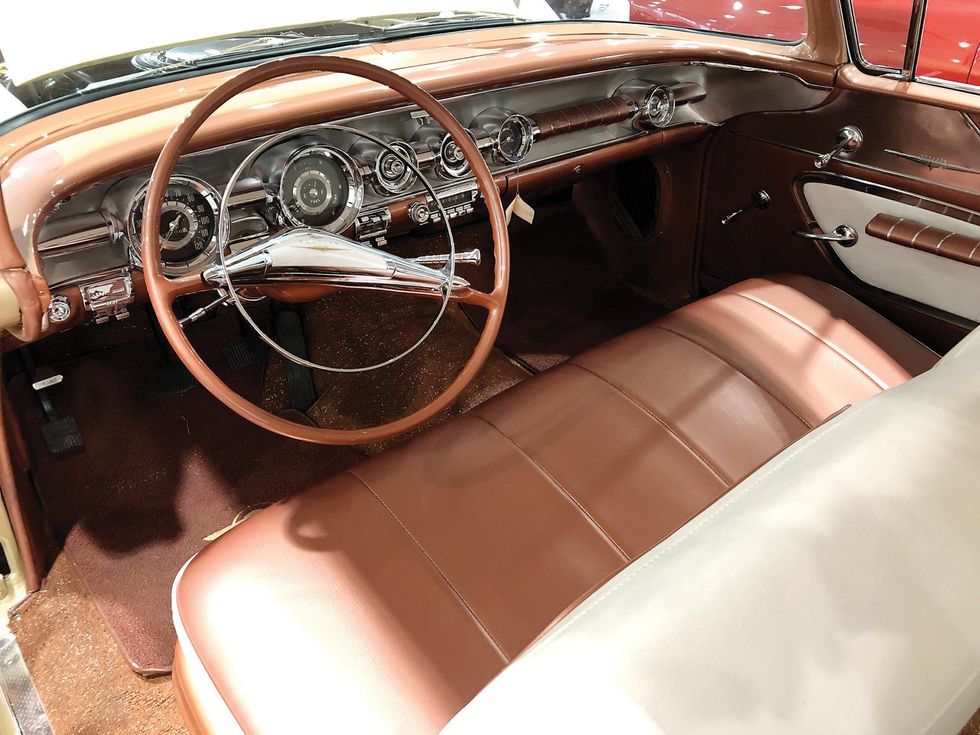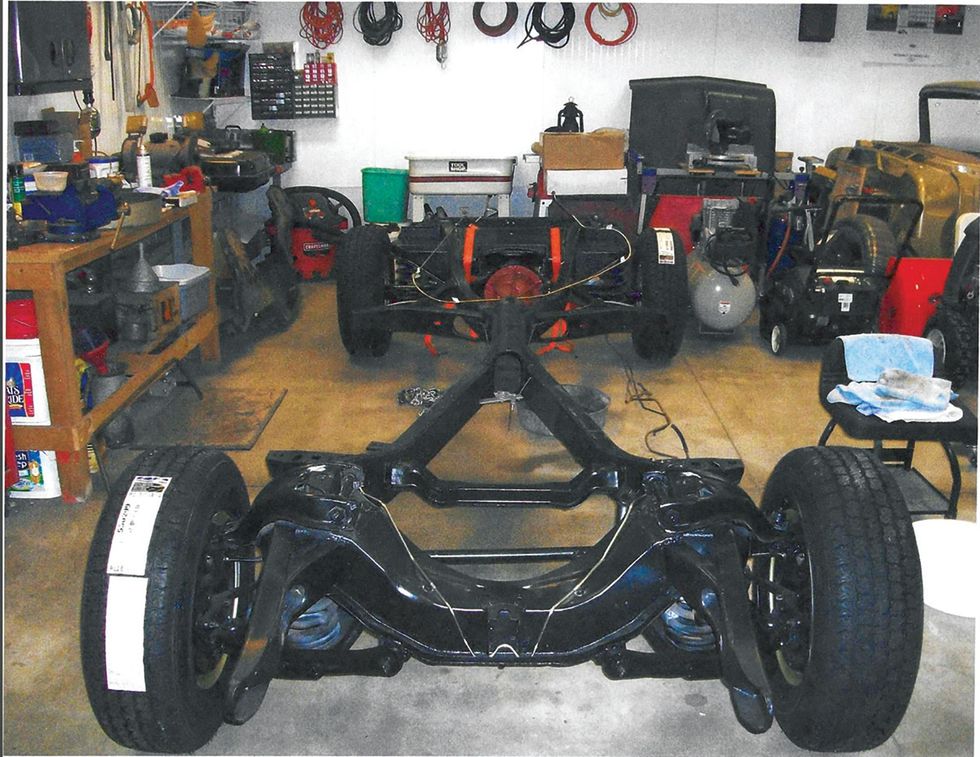This car shouldn’t even exist. Every Pontiac collector who has encountered it has said so. Yet here it is, with three two-barrels atop its "Extra Horsepower," 300-hp, 370-cu.in. V-8; the basic M11 Muncie three-speed controlled by a column shifter; and Patina Ivory over Jubilee Gold paint. The manual transmission and Tri-Power are what draw in the casual observer, but it’s that paint that throws all the experts. It shouldn’t be on this car, yet the evidence is all there to say it was built this way.
Model year 1958 marked a half-century since the founding of General Motors. To commemorate the occasion, Pontiac produced a limited (sources indicate under 1,200 were built) run of Star Chiefs wearing Golden Jubilee badging and wearing Jubilee Gold paint. The only catch is those cars were all four-door sedans. This is the only two-door hardtop known in the color, and nobody was even aware of it until about 20 years ago, when owner David Rogalla of Grand Forks, North Dakota, bought it from the children of the original owner.
That may be surprising, given how well-documented Pontiacs tend to be these days, but those cars —the ones that can be verified via PHS Automotive Services—were all built from 1961 to 1986. The earlier records simply don’t exist—if they ever did. Henry Ford may have been the one to say, "history is more or less bunk" and that only the history being made in the present matters, but the idea pervades Detroit. It’s volume that matters, not record keeping.

To collectors, though, history matters. David didn’t even know he had something special when he bought this ’58. He just figured he had purchased a restorable 1958 Star Chief. Only when that restoration started did he learn he had something seemingly unique.
"I’ve had several Pontiacs in my life," he recalls. "The two that stood out to me most were a ’56 Star Chief four-door hardtop with factory air and a ’58 Chieftain I had. I loved the ’58, the dashboard, and everything about the car.
"My old ’58 was a Tri-Power, automatic car. When I was in the service, my dad wrote me a letter that said, ‘That car has quite a reputation.’ Which it did!"

That reputation may have been why the car wasn’t waiting for David on his return: "My father sold it while I was in the service." The car was gone, but not forgotten. "I told my wife I’d like to have another one."
The desire remained unfulfilled for years. Many other older cars passed through David’s hands, but another ’58 Pontiac proved elusive until 2002, when David saw an advertisem*nt in the late, lamented Cars & Parts publication.
"I found a standard-transmission, Tri-Power Star Chief in Waukegan, Illinois," David says. Waukegan is 700 miles from Grand Forks, but David, who’s in the trucking industry, didn’t hesitate to call the seller. "He told me that his dad bought the car new. He had passed away and they were going to sell it."
David happened to have a truck nearby and upon hearing that he’d be the second owner of this car, he quickly arranged to have it on its way to his garage. At the time, the most notable feature beyond the triple-carburetor setup was the manual transmission —long a hallmark of a "hot" car and atypical for a 1958 Pontiac— especially a long-wheelbase car. Of 73,019 Super and Star Chiefs built for the model year, only 258 came with a manual transmission rather than the Super Hydra-Matic.
Interestingly, the hotter versions of the 370 —which also came in 310- (Rochester fuel-injected), 315- ("Tempest 395" with four-barrel), and 330-hp ("Tempest 395" with Tri-Power) iterations —were apparently capable of overpowering the M11 three-speed, and late in the year Pontiac reintroduced its heavy-duty transmission, the M13. In 1957 and before, that transmission had been shared with the Buick Century and Roadmaster, but for 1958 it was actually the Borg-Warner T85.
Once the car got to North Dakota, the matter of the transmission would be wholly eclipsed by the greater mystery of the paint color. How did a dealership in Illinois manage to get a car built with a paint code supposedly applicable only to the Golden Jubilee cars? Did the original owner have some pull with General Motors?
The seller’s father was a man named Charles Pitts. Paperwork included with the sale indicated he’d purchased the car at Gustafson Motors, Inc., in Libertyville, Illinois, just 10 miles from Waukegan, on May 18, 1958 —trading in his 1956 Star Chief four-door at the same time. The purchase agreement specified the only options as whitewalls, Tri-Power, and the two-tone paint. There’s also a marginal notation, in the same hand as the rest of the form, further explaining the two-tone as "All Gold, Ivory Accent & Top."
Unfortunately, at the time of the initial purchase, David had no reason to know the color of his Star Chief was special, and all his efforts over the intervening two decades to regain contact with the original owner’s family have been thwarted by the demise of land lines and phone books. "I wish I could get ahold of the Pitts family, but I have no idea how to do it."

Where the original family has gone missing, vintage-Pontiac connoisseurs have stepped in. The issue of the paint came up because the original finish had been covered by a questionable update.
"When I got the car, it was black with blue flames and not very pretty. My wife was kinda disgusted and she said, ‘That’s not going in the garage!’ But I looked it over and it had just 38,000 miles on it, the clock worked, and it wasn’t rusted out or anything like that. It was just this terrible paint job.
"I did some research on the car and found it was a Z-code. We have an old dealership here in Grand Forks, Lyons, and they go back to the late 1800s. They have a lot of books and I asked them ‘What color is a Z-code?’ They said there’s no such thing."
In search of greater expertise, David signed up for the Pontiac-Oakland Club International, and attended the Rapid City, South Dakota, convention. David told one POCI official that he’d just acquired a Z-code 1958 Star Chief Catalina two-door.
"He said ‘No you didn’t, they didn’t make one.’" That’s a refrain David heard again and again, but with the paperwork and known history of the car, however, seemingly nobody disputes that this is the real thing and incredibly rare —likely the only one.
"I thought, ‘Jeepers, maybe I should do a good restoration on this car instead of just making it a driver.’ I’ve had a lot of old cars, but I’d never done anything like that before."
The idea of a concours-level restoration was new territory for David, who had historically just enjoyed his old cars as road machines, not show ponies. Once set on that path, however, he leaned into it—making sometimes extreme efforts to achieve factory perfection.
"It took me quite a few years to find all the correct parts. I would go to POCI conventions, and I wanted to get everything as correct as I could get it."

Take the headlamps, for example: They’re original 1958 units ("I use them sparingly because I don’t want to wear them out," David says) that he purchased as new old stock from a seller in Iowa — one who turned out to be another skeptic for conversion.
"He told me the car was impossible, but I sent him a rubbing of the firewall tag." Suitably convinced, the seller sent along a bonus with the headlights —an NOS cookie plate from an Iowa dealership used to promote the new 1958 Pontiacs and GM’s 50th anniversary, which David displays along with the car today.
Carpet was another major challenge for the restoration. The wheelbase differences between 1958 Pontiacs show up in the rear-seat area, so flooring intended for a Chieftain or Bonneville won’t fit correctly in a Super Chief or Star Chief.
"I could not find bronze carpet," David recalls, though more conventional colors were available. Compounding the problem was the size issue. "This gold-flecked carpet was only done in Bonnevilles. I was told to call a guy up in Michigan who might have a set." That man proved to be a Pontiac retiree who had acquired a lot of NOS parts during his career.
"He said ‘Yes, I do, and it’s going to be very expensive: $3,500.’" But, knowing that the carpets he’d just found were "probably the only ones" in existence, David paid up.
"I sent him a cashier’s check and it never came." Months passed, but the issue wasn’t fraud —it was health. David learned that the seller had a stroke and was incapacitated. The family was attempting to locate the carpet. "He had stuff stored all over the state of Michigan. Finally in the last part of January, it arrived, and it was absolutely perfect in color, brand new from GM."
Other parts of the restoration weren’t so challenging. As hinted by the functional clock and relatively low mileage, even as a Chicago-area car, the ’58 was in pretty good shape.
"There wasn’t much bodywork to do on the car, it was pretty straight, we just sanded it down to the bare metal and put fresh paint on," David says. Likewise, the stainless trim proved undented and easily polished to a like-new luster. The engine, also "didn’t need much at all, so we did the body and got the chrome redone and got everything done on the car."
With so much redone to perfection, David could not resist keeping just a few things in unrestored condition, as a nod to the original Pontiac craftsmen who built the car. "I never touched the little airplanes on the fenders, or the hubcaps. They are exactly from the factory as they were. I didn’t even repaint the black in them. I wanted something absolutely original to the car."
The end result is an effectively perfect recreation of how this mysterious car must have looked that day in May it was delivered at Gustafson Motors. If only we knew how and why it came to be.















